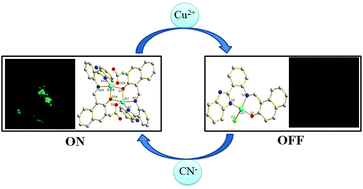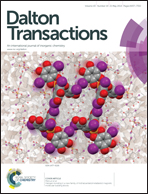A highly selective and sensitive Zn(ii) complex-based chemosensor for sequential recognition of Cu(ii) and cyanide†
Abstract
Two new Schiff base complexes, [ZnL(Ac)]2 (1) and [CuLCl]·H2O (2) (HL = 2-(2′-hydroxynaphthylmethylene)aminophenylbenzimidazole, Ac = acetate) were synthesized by a one-pot reaction and characterized by elemental analyses, IR and single-crystal X-ray diffraction. Fluorescence of complex 1 showed “on–off–on” switching when Cu2+ and cyanide were sequentially detected. This phenomenon was investigated by UV-Vis absorption, fluorescence and ESI-MS spectra, and theoretical calculations to explain the response. Complex 1 can selectively respond to Cu2+ with the fluorescence “turn-off” owing to the formation of complex 2 in the solution. Interestingly, the quenched fluorescence of complex 1 by Cu2+ ions could be turned on after the addition of cyanide owing to the displacement of L− by CN− to form [Cu(CN)x]n−, making complex 1 a selective CN− probe. In addition, the results of the MTT assay experiment indicate that complex 1 has a low toxicity to cells and can be used to detect intracellular Cu2+ ion by live cell imaging.


 Please wait while we load your content...
Please wait while we load your content...